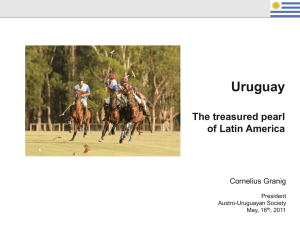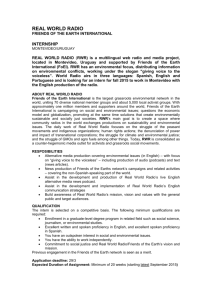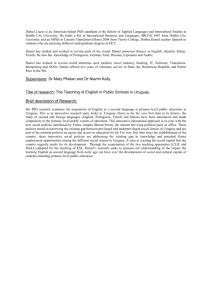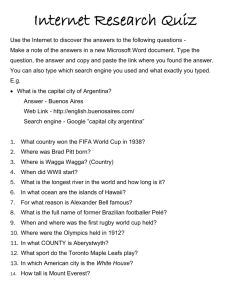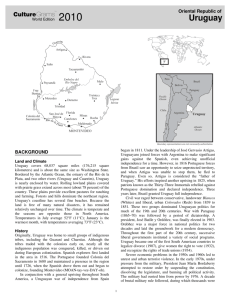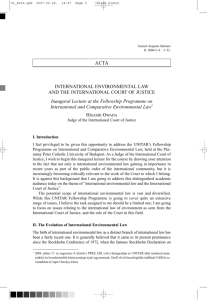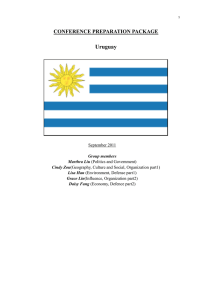Infrastructure
advertisement
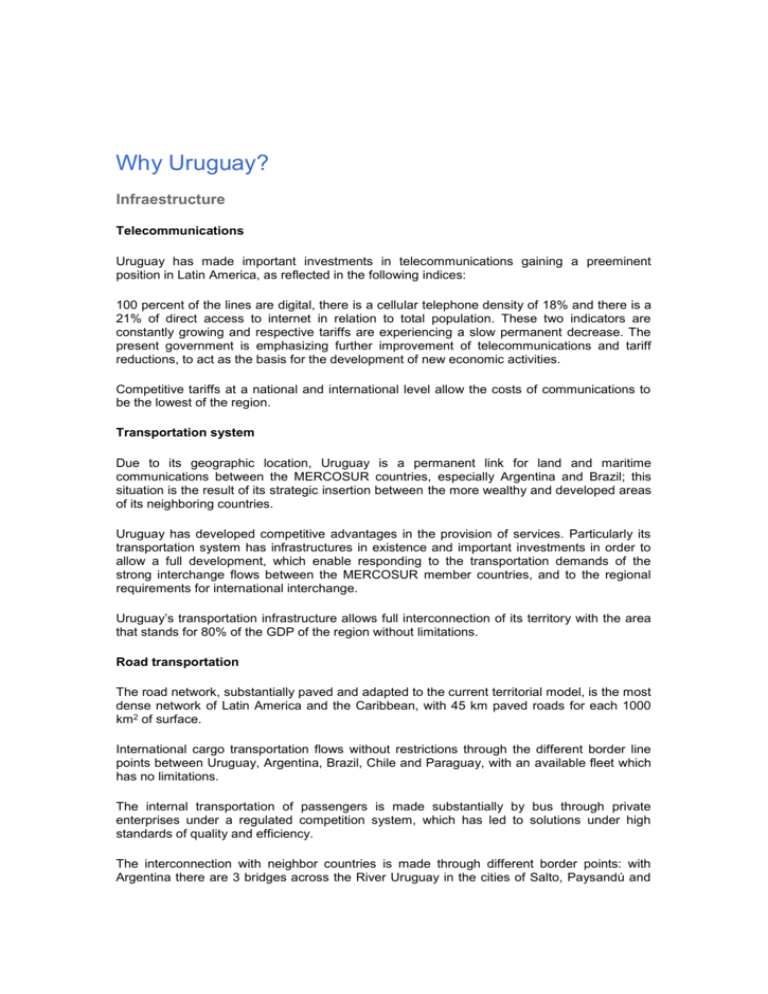
Why Uruguay? Infraestructure Telecommunications Uruguay has made important investments in telecommunications gaining a preeminent position in Latin America, as reflected in the following indices: 100 percent of the lines are digital, there is a cellular telephone density of 18% and there is a 21% of direct access to internet in relation to total population. These two indicators are constantly growing and respective tariffs are experiencing a slow permanent decrease. The present government is emphasizing further improvement of telecommunications and tariff reductions, to act as the basis for the development of new economic activities. Competitive tariffs at a national and international level allow the costs of communications to be the lowest of the region. Transportation system Due to its geographic location, Uruguay is a permanent link for land and maritime communications between the MERCOSUR countries, especially Argentina and Brazil; this situation is the result of its strategic insertion between the more wealthy and developed areas of its neighboring countries. Uruguay has developed competitive advantages in the provision of services. Particularly its transportation system has infrastructures in existence and important investments in order to allow a full development, which enable responding to the transportation demands of the strong interchange flows between the MERCOSUR member countries, and to the regional requirements for international interchange. Uruguay’s transportation infrastructure allows full interconnection of its territory with the area that stands for 80% of the GDP of the region without limitations. Road transportation The road network, substantially paved and adapted to the current territorial model, is the most dense network of Latin America and the Caribbean, with 45 km paved roads for each 1000 km2 of surface. International cargo transportation flows without restrictions through the different border line points between Uruguay, Argentina, Brazil, Chile and Paraguay, with an available fleet which has no limitations. The internal transportation of passengers is made substantially by bus through private enterprises under a regulated competition system, which has led to solutions under high standards of quality and efficiency. The interconnection with neighbor countries is made through different border points: with Argentina there are 3 bridges across the River Uruguay in the cities of Salto, Paysandú and Fray Bentos, whereas with Brazil highways converge in the towns of Artigas, Rivera, Río Branco and Chuy. The distances between Montevideo and the main cities of the region are the following (in km.): Bs. As. Rosario Santa Fe Córdoba Mendoza San Pablo Río de Janeiro Porto Alegre Asunción Santiago 640 250 230 200 880 740 1050 1520 1970 2400 870 1550 1900 By road Future bridge River-road River The Colonia-Buenos Aires bridge In the framework of a plan to improve the infrastructure and interconnection within the regional integration process, an expansion of the capacity of the west-east corridor between Colonia-Montevideo-Punta del Este is currently under construction, with the idea of having available a double four-track highway for greater capacity and security which, connected through the Colonia-Buenos Aires bridge, will constitute a quick access way between Argentina and the East of Uruguay. Moreover, it will constitute a quick access way between Argentina and the south of Brazil. The Colonia-Buenos Aires bridge which will be 40 km. long, represents an investment in the region of US$ 800 million, to be recovered through toll revenues (estimated at US$ 90 million per year). Added benefits are the valuation of the real estate in its zone of influence in Uruguayan territory and the projection of the Uruguay River coast as an all-year-round tourist resource. Southern Cone Highway Hub This toll speed-way will enable connecting Buenos Aires in Argentina, with Sao Paulo in Brazil, covering a distance of about 2500 km. It is a supplementary project to the ColoniaBuenos Aires bridge. Railroad transportation The Uruguayan railroad network is single standard track, except for 11 km of double track in the access to Montevideo. Interconnection with Argentina is made without changing of track whereas this change is necessary with Brazil. The system is operated by the State Railroad Administration (AFE) an autonomous state enterprise opened to the participation of private operators. The network is structured in three main lines which converge in the central station, next to the port of Montevideo, which has direct access from the railroad system. The railroad transportation rates are competitive with truck rates in the segments of bulk demands served by the railroad. Railroad passenger transportation operates in two small short distance interurban segments which are of minor importance to the system. River and sea transportation The main local port of Montevideo, is the deepest natural port of the River Plate area. It receives sea lines from all over the world and concentrates the export, import and transit trade. It is the first and only terminal in the Atlantic coast of South America that operates under the free port system. The port is a terminal which, within its boundaries, is a zone of customs exclusion where private operators offer a number of services of international level including container, terminal and container warehousing. Paraguay-Paraná waterway The port of Nueva Palmira, the terminal of the Paraná-Paraguay waterway, is in full expansion. This waterway, 3.442 km. long, includes the River Plate and the Paraguay and Paraná rivers connecting the center of South America with the Atlantic coast, i.e., the most important river transportation system in South America. This requires investments identified for the improvement of the navigation in the waterway of about US$ 120 million plus an important investment in fleet and port improvements. Uruguay intends to grant concessions of both sea and river port installations for the transshipment of grains, located in the port of Nueva Palmira, which involves the exploitation of docks, silos and transshipment equipment and the expansion of equipment and infrastructure. Air transportation The main airport installations are in the zone that concentrates population and tourist infrastructure, between Montevideo and Punta del Este. Carrasco International Airport is located east of Montevideo 18 km from down-town and is the main air terminal of Uruguay. Intercontinental connections are in charge of 10 international airlines with regular passenger and air cargo services, some on a daily basis. Currently in a project stage, a remodel and enlargement program for the Carrasco International Airport will be completed through private investment, in order to improve the existing infrastructure. Laguna del Sauce Airport is located 15 km away from Punta del Este and both its terminal building and runways have been fully renovated. Energy The basic sources of primary energy in Uruguay are hydroelectric gas and petroleum. The limitations in the hydroelectric potential in Uruguay facing an increasing demand have focused government policy on incorporating new sources of energy in the national energy plan. Current efforts are directed to introducing natural gas from the neighbor countries. Gas pipeline A 250 km. long gas pipeline was constructed between Montevideo and Buenos Aires. This construction is transporting between 2 and 2.5 million cubic meters per day of natural gas between Argentina and Uruguay, which is used basically to generate electricity. The pipeline feeds, apart from homes and industries, a power plant currently in process of construction. The plant will transform the energy into cheaper electricity. It has already been constructed the “Litoral” pipeline, that transports gas from Entre Ríos in Argentina to Paysandú in Uruguay. This 20 km. long pipeline, feeds the cement and alcohol plants of ANCAP, the industries of Paysandú, and the “city gate” from which the distribution network to homes is supplied. Energy deregulation As established in the law deregulating the energy production, thermo electric units may be built by the private sector under the BOT system (build, operate and transfer) and the electricity produced can be marketed to large consumers or to the state utility (UTE). Water supply The supply of potable water is available throughout the country permanently, complying with the World Health Organization (OMS) standards on potable water. The state company in charge of the supply of water, OSE, is undertaking several significant plans for improving the system through contracting private local and foreign companies for the related construction work.


